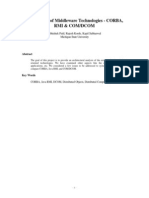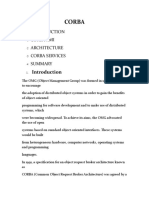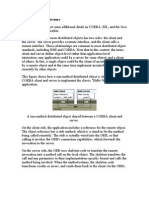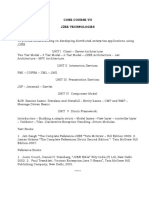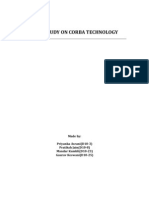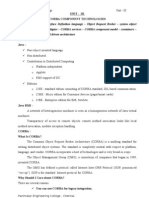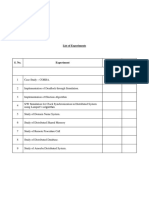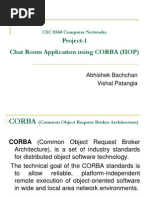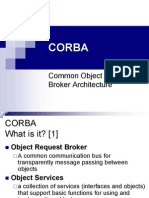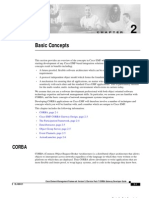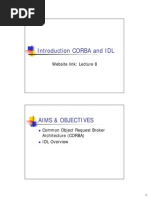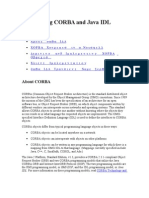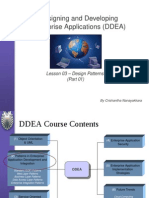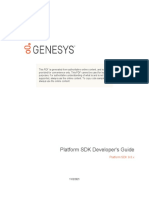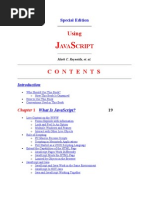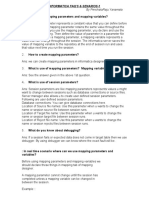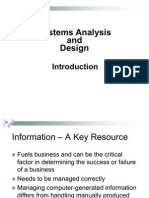Sections 9.1 & 9.2: Corba & DCOM
Sections 9.1 & 9.2: Corba & DCOM
Uploaded by
Khaja HussainCopyright:
Available Formats
Sections 9.1 & 9.2: Corba & DCOM
Sections 9.1 & 9.2: Corba & DCOM
Uploaded by
Khaja HussainOriginal Title
Copyright
Available Formats
Share this document
Did you find this document useful?
Is this content inappropriate?
Copyright:
Available Formats
Sections 9.1 & 9.2: Corba & DCOM
Sections 9.1 & 9.2: Corba & DCOM
Uploaded by
Khaja HussainCopyright:
Available Formats
Introduction
CORBA
Distributed COM
Sections 9.1 & 9.2
Corba & DCOM John P. Daigle
Department of Computer Science Georgia State University
05.16.06
Introduction
CORBA
Distributed COM
Outline
1 2
Introduction CORBA Overview Communication Processes Naming Other Design Concerns Distributed COM Overview Naming Fault Tolerance & Security
Introduction
CORBA
Distributed COM
Outline
1 2
Introduction CORBA Overview Communication Processes Naming Other Design Concerns Distributed COM Overview Naming Fault Tolerance & Security
Introduction
CORBA
Distributed COM
CORBA and DCOM
CORBA CORBA stands for Common Object Request Broker Architecture. Specication Developed by the Object Management Group (UML Authors) The essence of CORBA is separation of interface from implementation (from OMG web site) DCOM Distributed Component Object Model Microsoft Technology
Introduction
CORBA
Distributed COM
What are these things?
CORBA and DCOM are Distributed Object Based Systems
Introduction
CORBA
Distributed COM
Outline
1 2
Introduction CORBA Overview Communication Processes Naming Other Design Concerns Distributed COM Overview Naming Fault Tolerance & Security
Introduction
CORBA
Distributed COM
Object Model
Client machine Client application Static IDL proxy Dynamic Invocation Interface Client ORB Local OS ORB interface Object adapter Server machine Object implementation Skeleton Dynamic Skeleton Interface ORB interface
Server ORB Local OS
Network
ORB Object Request Broker: the Core of a CORBA system, enables communication between objects and their clients. IDL Interface Denition Language provides a precise syntax for describing methods and parameters, static Dynamic Invocation Interface Runtime tool for clients to construct an invocation request at runtime.
Introduction
CORBA
Distributed COM
Interface, services
Interface & Implementation Repository Interface Repository Stores all interface denitions IDL compiler assigns a repository identier to each interface on compilation Standardized to IDL syntax Implementation Repository Stores all information needed to implement objects. Closely coupled to OS and ORB (which is non standard) CORBA Services Conceptually, CORBA services are the operating system of the CORBA distributed platform. Services are general purpose Services are independent of application
Introduction
CORBA
Distributed COM
List of CORBA services (p. 500)
Service Collection Query Concurrency Transaction Event Notication Externalization Life cycle Licensing Naming Property Trading Persistence Relationship Security Time Description Facilities for grouping objects into lists, queue, sets, etc. Facilities for querying collections of objects in a declarative manner Facilities to allow concurrent access to shared objects Flat and nested transactions on method calls over multiple objects Facilities for asynchronous communication through events Advanced facilities for event-based asynchronous communication Facilities for marshaling and unmarshaling of objects Facilities for creation, deletion, copying, and moving of objects Facilities for attaching a license to an object Facilities for systemwide naming of objects Facilities for associating (attribute, value) pairs with objects Facilities to publish and nd the services an object has to offer Facilities for persistently storing objects Facilities for expressing relationships between objects Mechanisms for secure channels, authorization, and auditing Provides the current time within specied error margins
Introduction
CORBA
Distributed COM
Object Invocation Models
How does the client connect to an object?
Request Type Snychronous Failure Semantics At-most-once Description Caller blocks until a response is returned or an exception is raised Caller continues immediately without waiting for any response from the server Caller continues immediately and can later block until response is delivered
One-way
Best effort delivery
Deferred Synchronous
At-most-once
Introduction
CORBA
Distributed COM
Event & Notication Services
Push event to consumers Consumer Event channel Consumer Supplier Supplier Supplier
Push Model Objects wait passively to be informed when an event occurs.
Ask suppliers for new event Consumer Event channel Consumer Supplier Supplier Supplier
Pull Model Objects poll the event channel to check for events. Both models are inherently unreliable, and neither allows ltering of messages.
Introduction
CORBA
Distributed COM
Messaging Service
CORBA also provides a more reliable communication method for persistent communication. This is an object oriented communication service.
Client application 1. Call by the application Client proxy Client ORB 2. Request to server Callback interface 4. Call by the ORB 3. Response from server
Callback model: application driven, application supported
Introduction
CORBA
Distributed COM
Messaging Service
CORBA also provides a more reliable communication method for persistent communication. This is an object oriented communication service.
Client application 1. Call by the application Client proxy Client ORB 2. Request to server Polling interface 3. Response from server 4. Call by the application
Polling Model: application driven, ORB supported
Introduction
CORBA
Distributed COM
Interoperability
GIOP There is a need in CORBA for different ORBs on different platforms to be able to communicate. GIOP General Inter-ORB protocol: must run on top of an existing transport protocal, such as TCIP.
Introduction
CORBA
Distributed COM
Clients
One unique aspect of client software in CORBA is the idea of an interceptor, which allows client side software to be modied as needed by modifying the input or output, rather than the software itself.
Client application Client proxy Request-level interceptor Client ORB Message-level interceptor Local OS To server
Invocation request
Introduction
CORBA
Distributed COM
Object References
Important: In CORBA, it is essential to distinguish specication-level and implementation-level (object references Specication level: An object reference is considered to be the same as a proxy for the referenced object having an object reference means you can directly invoke methods; there is no separate client-to-object binding phase Implementation level: When a client gets an object reference, the implementation ensures that, one way or the other, a proxy for the referenced object is placed in the clients address space Conclusion: Object references in CORBA used to be highly implementation dependent: different implementations of CORBA could normally not exchange their references.
Introduction
CORBA
Distributed COM
Interoperable Object References
Because object references are implementation dependent, CORBA requires a way to package object references to allow them to be universally understood.
Tagged Profile Interoperable Object Reference (IOR) Repository identifier Profile ID Profile
IIOP version
Host
Port
Object key
Components
POA identifier
Object identifier
Other serverspecific information
ProleID Field The part of the tagged prole that contains the complete information needed to invoke the object.
Introduction
CORBA
Distributed COM
Interoperable Object References
Because object references are implementation dependent, CORBA requires a way to package object references to allow them to be universally understood.
Tagged Profile Interoperable Object Reference (IOR) Repository identifier Profile ID Profile
IIOP version
Host
Port
Object key
Components
POA identifier
Object identifier
Other serverspecific information
ProleID Field The part of the tagged prole that contains the complete information needed to invoke the object.
Introduction
CORBA
Distributed COM
Interoperable Object References
Because object references are implementation dependent, CORBA requires a way to package object references to allow them to be universally understood.
Tagged Profile Interoperable Object Reference (IOR) Repository identifier Profile ID Profile
IIOP version
Host
Port
Object key
Components
POA identifier
Object identifier
Other serverspecific information
ProleID Field The part of the tagged prole that contains the complete information needed to invoke the object. IIOP version The version Number for this prole
Introduction
CORBA
Distributed COM
Interoperable Object References
Because object references are implementation dependent, CORBA requires a way to package object references to allow them to be universally understood.
Tagged Profile Interoperable Object Reference (IOR) Repository identifier Profile ID Profile
IIOP version
Host
Port
Object key
Components
POA identifier
Object identifier
Other serverspecific information
ProleID Field The part of the tagged prole that contains the complete information needed to invoke the object. Host Location of this object (for example, an IP or DNS)
Introduction
CORBA
Distributed COM
Interoperable Object References
Because object references are implementation dependent, CORBA requires a way to package object references to allow them to be universally understood.
Tagged Profile Interoperable Object Reference (IOR) Repository identifier Profile ID Profile
IIOP version
Host
Port
Object key
Components
POA identifier
Object identifier
Other serverspecific information
ProleID Field The part of the tagged prole that contains the complete information needed to invoke the object. Object Key Server specic information for demultiplexing incoming requests to the appropriate object.
Introduction
CORBA
Distributed COM
Interoperable Object References
Because object references are implementation dependent, CORBA requires a way to package object references to allow them to be universally understood.
Tagged Profile Interoperable Object Reference (IOR) Repository identifier Profile ID Profile
IIOP version
Host
Port
Object key
Components
POA identifier
Object identifier
Other serverspecific information
ProleID Field The part of the tagged prole that contains the complete information needed to invoke the object. Components Additional information such as security information.
Introduction
CORBA
Distributed COM
The CORBA Naming Service
Essence: CORBAs naming service allows servers to associate a name to an object reference, and have clients subsequently bind to that object by resolving its name Observation: In most CORBA implementations, object references denote servers at specic hosts; naming makes it easier to relocate objects Observation: In the naming graph all nodes are objects; there are no restrictions to binding names to objects: CORBA allows arbitrary naming graphs Observation: There is no single root; an initial context node is returned through a special call to the ORB. Also: the naming service can operate across different ORBs
Introduction
CORBA
Distributed COM
Fault Tolerance
Remember that replication is the key to fault tolerance. Interoperable Object Group Reference
Interoperable Object Group Reference (IOGR) Repository identifier Profile ID Profile-1 Profile ID Profile-N
IIOP ver.
Host-1
Port-1
Object key-1
Components
IIOP ver.
Host-N Port-N
Object key-N
Components
TAG PRIMARY
Other groupspecific information
TAG BACKUP
Other groupspecific information
Note: IOGRs have the same structure as IORs; the main difference is that they are used differently. In IORs an additional prole is used as an alternative; in IOGR, it denotes another replica.
Introduction
CORBA
Distributed COM
Security
Essence: Allow the client and object to be mostly unaware of all the security policies, except perhaps at binding time; the ORB does the rest. Specic policies are passed to the ORB as (local) objects and are invoked when necessary:
Client application Set of client-specific policy objects Set of object-specific policy objects Object implementation
Security service
Policy object Policy object
Policy object Policy object
Security service
Security service Client ORB Local OS
Security service Server ORB Local OS
Set of relevant ORB security services
Network Invocation
Examples: Type of message protection, lists of trusted parties.
Introduction
CORBA
Distributed COM
Outline
1 2
Introduction CORBA Overview Communication Processes Naming Other Design Concerns Distributed COM Overview Naming Fault Tolerance & Security
Introduction
CORBA
Distributed COM
Acronyms
COM Component Object Model OLE Object Linking & Embedding Active X Everything that isnt COM
ActiveX Documents Grouping (Controls) Document linking In-place editing Drag and drop Scripting
OLE
Embedding
Interprocess data transfer COM Persistent storage
Persistent references
Object activation
Core COM library
Introduction
CORBA
Distributed COM
Object Model
Interfaces are Binary, essentially, a DCOM interface is a collection of pointers to implementations of methods. Each interface is typed, and therefore has a globally unique interface identier A client always requests an implementation of an interface:
Locate a class that implements the interface Instantiate that class, i.e., create an object Throw the object away when the client is done
The DCOM equivalent to the Interface Repository is the type library
Introduction
CORBA
Distributed COM
DCOM Services
CORBA Collection Query Concurrency Transaction Event Notication Externalization Life cycle Licensing Naming Property Trading Persistence Relationship Security Time DCOM/COM+ ActiveX Data Objects None Thread concurrency COM+ Automatic Transactions COM+ Events COM+ Events Marshaling utilities Class factories, JIT activation Special class factories Monikers None None Structured storage None Authorization None Windows 2000 Distributed Transaction Coordinator Active Directory Active Directory Active Directory Database access Database access SSL, Kerberos None
Note: COM+ is effectively COM plus services that were previously available in an ad-hoc fashion
Introduction
CORBA
Distributed COM
Communication
Object invocations: Synchronous remote-method calls with at-most-once semantics. Asynchronous invocations are supported through a polling model, as in CORBA. Event communication: Similar to CORBAs push-style model:
Supplier Event class object Consumer m_event
Interface containing m_event
Event object
Consumer m_event
Invocation is stored Event store
Invocation is passed to consumer
Object implementing m_event
Messaging: Completely analogous to CORBA messaging.
Introduction
CORBA
Distributed COM
Processes
Client side processes in DCOM are generally handled as if all objects are running locally. Passing object references between machines requires passing unique ID information, location, and other binding information. The wrapping is done by the proxy:
Process A Client application Client proxy Proxy (un)marshaler Marshaled client proxy Process B Client application Proxy (un)marshaler Client proxy
Binding information Object stub
Same binding information Object
Object server
Introduction
CORBA
Distributed COM
Monikers
DCOM Objects are Temporary To accommodate objects that can outlive their client, something else is needed. A Moniker is a persistent reference, a hack to support real objects A moniker associates data (e.g., a le), with an application or program Monikers can be stored A moniker can contain a binding protocol, specifying how the associated program should be launched with respect to the data. 1 2 3 4 5 6 7 Client Moniker SCM Class object Moniker Object Moniker Calls BindMoniker at moniker Lookup CLSID and tell SCM to create object Loads class object Creates object, returns int. pointer Instructs object to load previously stored state Loads its state from le Returns interface pointer of object to client
Introduction
CORBA
Distributed COM
Active Directory
A worldwide distributed directory service, but one that does not provide location transparency. Basics: Associate a directory service (called domain controller) with each domain; look up the controller using a normal DNS query:
DNS
1. Ask for host address of domain controller in a given domain
2. Requested address
3. LDAP query Client 4. LDAP reply Domain controller
Domain controllers can be grouped into trees and forests, and indexed at that level.
Introduction
CORBA
Distributed COM
Fault Tolerance
Automatic transactions: Each class object (from which objects are created), has a transaction attribute that determines how its objects behave as part of a transaction:
Attr. value REQUIRES_NEW REQUIRED SUPPORTED NOT_SUPPORTED DISABLED Description A new transaction is always started at each invocation A new transaction is started if not already done so Join a transaction only if caller is already part of one Never join a transaction (no transaction support) Never join a transaction, even if told to do so
Note: Transactions are essentially executed at the level of a method invocation.
Introduction
CORBA
Distributed COM
Declaritive Security I
DCOM Security is based on roles. The registry keeps an access control list for its entries, specifying the access privileges for each group.
Auth. level NONE CONNECT CALL PACKET PACKET_INTEGRITY PACKET_PRIVACY Description No authentication is required Authenticate client when rst connected to server Authenticate client at each invocation Authenticate all data packets Authenticate data packets and do integrity check Authenticate, integrity-check, and encrypt data packets
Delegation: A server can impersonate a client depending on a level:
Impersonation ANONYMOUS IDENTIFY IMPERSONATE DELEGATE Description The client is completely anonymous to the server The server knows the client and can do access control checks The server can invoke local objects on behalf of the client The server can invoke remote objects on behalf of the client
You might also like
- XAL External Interface For Alert ManagementDocument76 pagesXAL External Interface For Alert ManagementcommanderstrakerNo ratings yet
- Distributed Object-Based System: CORBA : Common Object Request Broker ArchitectureDocument31 pagesDistributed Object-Based System: CORBA : Common Object Request Broker ArchitectureVenu Gopal PNo ratings yet
- Handout (IPT Midterm)Document21 pagesHandout (IPT Midterm)Jel MCNo ratings yet
- ITSE205-DataStructures and AlgorithmsDocument8 pagesITSE205-DataStructures and AlgorithmssomaNo ratings yet
- Last Practical Case StidyDocument5 pagesLast Practical Case StidyNeha BhuptaniNo ratings yet
- Corba: A Seminar Report OnDocument12 pagesCorba: A Seminar Report Ondhanalakshmi k sNo ratings yet
- Corba Rmi DcomDocument27 pagesCorba Rmi DcomVeeresh BaligeriNo ratings yet
- The Common Object Request Broker Architecture (CORBA)Document70 pagesThe Common Object Request Broker Architecture (CORBA)Thu Ngân PhạmNo ratings yet
- The Common Object Request Broker Architecture (CORBA)Document54 pagesThe Common Object Request Broker Architecture (CORBA)Samar ahmedNo ratings yet
- Lec 10 - Distributed Objects Model - CORBADocument26 pagesLec 10 - Distributed Objects Model - CORBAJunaid KhanNo ratings yet
- Corba Case StudyDocument7 pagesCorba Case StudyRiya TomarNo ratings yet
- The CORBAArchitectureDocument8 pagesThe CORBAArchitectureharsh991No ratings yet
- CH 4 Distributed SystemDocument6 pagesCH 4 Distributed Systemlucifer27meNo ratings yet
- CORBADocument13 pagesCORBAAnovar_ebooks100% (1)
- Corba TechnologyDocument19 pagesCorba Technologypooja170822No ratings yet
- Core Course Vii J2Ee Technologies ObjectiveDocument72 pagesCore Course Vii J2Ee Technologies ObjectivemahaNo ratings yet
- I.T Case StudyDocument29 pagesI.T Case StudyNiketan ManeNo ratings yet
- Case Study On CorbaDocument23 pagesCase Study On CorbaPratiksh JainNo ratings yet
- Corba RMI OWN RefcardDocument13 pagesCorba RMI OWN RefcardandregoetzNo ratings yet
- A Detailed Comparison of CORBA, DCOM and Java-RMIDocument14 pagesA Detailed Comparison of CORBA, DCOM and Java-RMIOlaoye Olajuwon Joseph100% (1)
- Project-1 Chat Room Application Using CORBA (IIOP) : CSC 8560 Computer NetworksDocument21 pagesProject-1 Chat Room Application Using CORBA (IIOP) : CSC 8560 Computer NetworksSushant KhatiwodaNo ratings yet
- What Is CORBADocument27 pagesWhat Is CORBAts.hcltechbee2022No ratings yet
- The Common Object Request Broker Architecture (CORBA)Document55 pagesThe Common Object Request Broker Architecture (CORBA)Anathole NiyonganaNo ratings yet
- Request Broker (ORB) - The Concept of An ORB Is This: When An Application Component Wants To Use ADocument17 pagesRequest Broker (ORB) - The Concept of An ORB Is This: When An Application Component Wants To Use ARajesh KumarNo ratings yet
- CORBADocument29 pagesCORBAJasonNo ratings yet
- Unit - Iii Corba Component TechnologiesDocument54 pagesUnit - Iii Corba Component TechnologiesYashwant GopalNo ratings yet
- Distributed Object-Based Systems The WWW Architecture Web ServicesDocument16 pagesDistributed Object-Based Systems The WWW Architecture Web ServicesPranav MadaanNo ratings yet
- 6 CORBA Overview: Client Object ImplementationDocument15 pages6 CORBA Overview: Client Object ImplementationAngelino AlvesNo ratings yet
- RGPVDocument37 pagesRGPVRocky SamuelNo ratings yet
- Java andDocument41 pagesJava andRavinder RajuNo ratings yet
- 1 Corba Vs RMI Vs DCOMDocument30 pages1 Corba Vs RMI Vs DCOMsgohb100% (1)
- Client-Server Software Development: Version 2 CSE IIT, KharagpurDocument13 pagesClient-Server Software Development: Version 2 CSE IIT, KharagpurbaazilpthampyNo ratings yet
- Corba - 2Document5 pagesCorba - 2krishnaNo ratings yet
- CORBA: Overview: ICS 199 Michael LeDocument19 pagesCORBA: Overview: ICS 199 Michael Lejene_florenceNo ratings yet
- Assignment (Cervantes)Document2 pagesAssignment (Cervantes)Kenneth Louie CervantesNo ratings yet
- Corba: Team 12 Jean Lefever Brian Podolny Teresa Chang Russ WeitzDocument39 pagesCorba: Team 12 Jean Lefever Brian Podolny Teresa Chang Russ WeitzKishore SharmaNo ratings yet
- Distributed Object-Based System: CORBA : Common Object Request Broker ArchitectureDocument17 pagesDistributed Object-Based System: CORBA : Common Object Request Broker ArchitectureVenu Gopal PNo ratings yet
- Distributed Objects and ComponentsDocument62 pagesDistributed Objects and ComponentsDinesh KumarNo ratings yet
- Introduction To Middlewares: IIIT CourseDocument28 pagesIntroduction To Middlewares: IIIT CoursePraveen KumarNo ratings yet
- Project-1 Chat Room Application Using CORBA (IIOP) : CSC 8560 Computer NetworksDocument21 pagesProject-1 Chat Room Application Using CORBA (IIOP) : CSC 8560 Computer NetworksSrikanth MarepalliNo ratings yet
- SEG3100: Large Scale Software Development Common Object Request Broker Architecture Overview: (OO Middleware) Why CorbaDocument5 pagesSEG3100: Large Scale Software Development Common Object Request Broker Architecture Overview: (OO Middleware) Why CorbaManish AgrawalNo ratings yet
- Lindemann2002 Chapter UsingCORBAMiddlewareInFiniteElDocument10 pagesLindemann2002 Chapter UsingCORBAMiddlewareInFiniteElJhonatan BlasNo ratings yet
- Unit 10 Distributed Object-Based SystemsDocument14 pagesUnit 10 Distributed Object-Based SystemsSuparna DasNo ratings yet
- The Corbaloc and Corbaname URLsDocument5 pagesThe Corbaloc and Corbaname URLsjcorderopNo ratings yet
- Corba: Common Object Request Broker ArchitectureDocument9 pagesCorba: Common Object Request Broker ArchitecturePuspala ManojkumarNo ratings yet
- Corba Unit 4Document4 pagesCorba Unit 4roshnibijuNo ratings yet
- Unit 3Document15 pagesUnit 3Sumita Barun kumarNo ratings yet
- CorbaDocument2 pagesCorbaShubham GawaliNo ratings yet
- Java Idl (Corba) : - Introduced in Version 1.2 of The Java 2 PlatformDocument29 pagesJava Idl (Corba) : - Introduced in Version 1.2 of The Java 2 PlatformNikolas KalyvasNo ratings yet
- NEW PROJECT LastDocument42 pagesNEW PROJECT Lastaj3751425No ratings yet
- (Ebook-Pdf) - Corba Programming UnleashedDocument610 pages(Ebook-Pdf) - Corba Programming UnleashedJulianNo ratings yet
- Basic ConceptsDocument6 pagesBasic Conceptswert83No ratings yet
- Part 1 - Introduction: CORBA DefinitionDocument5 pagesPart 1 - Introduction: CORBA DefinitionPaul BaniladNo ratings yet
- Distributed Object-Based SystemsDocument53 pagesDistributed Object-Based SystemsMarvin NjengaNo ratings yet
- Distributed Systems Programming Sockets: On TCP/IP NetworksDocument7 pagesDistributed Systems Programming Sockets: On TCP/IP NetworksJitendra Singh RauthanNo ratings yet
- 08 Introduction CORBA and IDL (To Use)Document43 pages08 Introduction CORBA and IDL (To Use)Phan Thế DuyNo ratings yet
- 5.4 Marshalling in Distributed SystemDocument13 pages5.4 Marshalling in Distributed SystemHamsitha ChoudharyNo ratings yet
- Using CORBA and Java IDLDocument8 pagesUsing CORBA and Java IDLWaseem SiddiquiNo ratings yet
- What Is CORBA - Introduction To CORBA - ProductsDocument2 pagesWhat Is CORBA - Introduction To CORBA - ProductsshivarinNo ratings yet
- Force.com Enterprise Architecture: Architect and deliver packaged Force.com applications that cater to enterprise business needsFrom EverandForce.com Enterprise Architecture: Architect and deliver packaged Force.com applications that cater to enterprise business needsNo ratings yet
- 8401x Na40 Enus DeviiDocument336 pages8401x Na40 Enus DeviiRavi RamrakhaniNo ratings yet
- Qlik Deployment Framework-Deployment Guide PDFDocument30 pagesQlik Deployment Framework-Deployment Guide PDFggNo ratings yet
- JAVA LEARN Easy NotesDocument7 pagesJAVA LEARN Easy Noteserenyeager132005No ratings yet
- Csi 07Document25 pagesCsi 07Mai Cao Thị ThanhNo ratings yet
- Thiru DBMS Viva-FAQsDocument13 pagesThiru DBMS Viva-FAQsdmprashanth6No ratings yet
- Design PatternsDocument71 pagesDesign PatternsJasintha Dasanayaka100% (2)
- JAVADocument175 pagesJAVAapi-3782519100% (2)
- PDF Data Volume Management - Best Practice 5000000006277Document29 pagesPDF Data Volume Management - Best Practice 5000000006277Pablo BlancoNo ratings yet
- ch-2 - Introduction To UMLDocument89 pagesch-2 - Introduction To UMLbhargavi100% (1)
- 2016-2017 Computer Programming 2 SyllabusDocument22 pages2016-2017 Computer Programming 2 SyllabusRhey CostalesNo ratings yet
- En PSDK 9.0.x Developer BookDocument596 pagesEn PSDK 9.0.x Developer Bookmhd hermawanNo ratings yet
- CS304 MId SolvedFULL FILE PDFDocument451 pagesCS304 MId SolvedFULL FILE PDFBest LatestNo ratings yet
- 4.1 Semantic Data and Web: Unit 4 OntologyDocument12 pages4.1 Semantic Data and Web: Unit 4 OntologyZarana KananiNo ratings yet
- SVA Encapsulation in UVM: Enabling Phase and Configuration Aware AssertionsDocument8 pagesSVA Encapsulation in UVM: Enabling Phase and Configuration Aware Assertionsgideontargrave7No ratings yet
- Using AVA Cript: Special EditionDocument577 pagesUsing AVA Cript: Special EditionSai VinayNo ratings yet
- OOP - Tieng AnhDocument114 pagesOOP - Tieng AnhVo Hoai NamNo ratings yet
- DFo - 1 - 3 - SG (Database Models)Document18 pagesDFo - 1 - 3 - SG (Database Models)irsadida.08No ratings yet
- PDF Manual - 1 PDFDocument100 pagesPDF Manual - 1 PDFRaju NaiduNo ratings yet
- Unit 1Document17 pagesUnit 1prapadhya uppalapatiNo ratings yet
- UGC-NET Computer ScienceDocument8 pagesUGC-NET Computer ScienceVikrant Sehgal100% (2)
- Autocad 2016: ObjectiveDocument5 pagesAutocad 2016: ObjectiveHari HaranNo ratings yet
- Bapi Idoc PresentationDocument13 pagesBapi Idoc Presentationapi-26420083100% (4)
- Arcreader ArcobjectsDocument29 pagesArcreader Arcobjectselrayah2No ratings yet
- OOPS Concepts MCQDocument12 pagesOOPS Concepts MCQJrk IndiaNo ratings yet
- BCA-V Activity List-2022Document12 pagesBCA-V Activity List-2022blahhwhocares69No ratings yet
- A Interview Faq's - 1Document25 pagesA Interview Faq's - 1yprajuNo ratings yet
- Advanced GoogleTest Topics - GoogleTestDocument40 pagesAdvanced GoogleTest Topics - GoogleTestjordan1412No ratings yet
- Object-Oriented Design Patterns in The Kernel, Part 1 (LWN - Net)Document49 pagesObject-Oriented Design Patterns in The Kernel, Part 1 (LWN - Net)Rishabh MalikNo ratings yet
- An Introduction To System Analysis and DesignDocument55 pagesAn Introduction To System Analysis and DesignedflookeNo ratings yet







